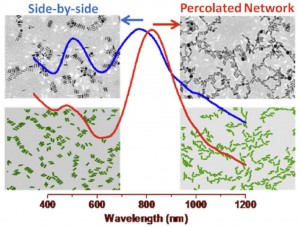Ritesh Agarawal, Russell J. Composto, Karen I. Winey

Figure: the longitudinal surface plasmon resonance first undergoes a blue shift because of side-by-side assembly and then a red shift upon network formation which occurs by end linking of NRs.
The assembly of nanowires within a bulk or thin film polymer matrix holds great promise for designing new materials with novel electrical and optical properties. This highlight focuses on metal nanowires functionalized with polymer brushes to control their assembly. Nanowire dispersion or aggregation of these nanowires within a polymer matrix is mainly determined by whether or not the polymer penetrates the brush. Composto has recently published two papers demonstrating how to design functionalized nanowire / polymer systems that control the nanowire separation and orientation and thereby control the optical adsorption.[1, 2] In addition to their comprehensive experimental studies, Composto incorporate Monte Carlo simulations to study self-assembly.
[1] M. J. A. Hore, A. L. Frischknecht, and R. J. Composto, ACS Macro Lett. 2012
[2] G. Jiang, M. J. Hore, S. Gam, R. J. Composto*, ACS Nano 2012
